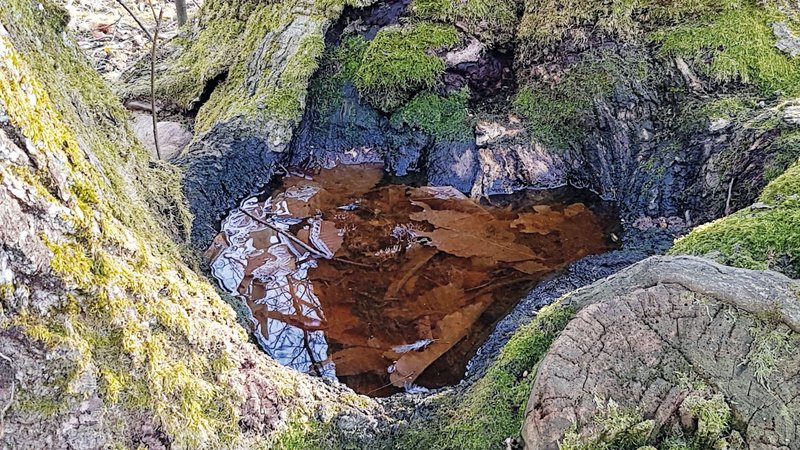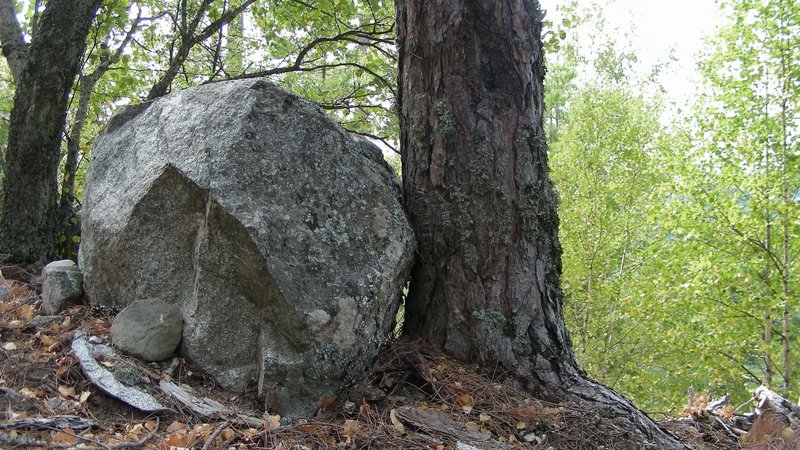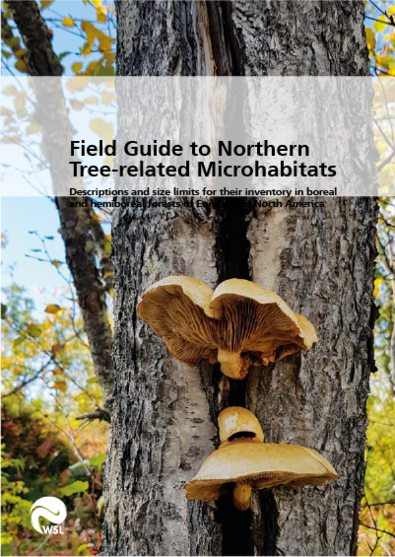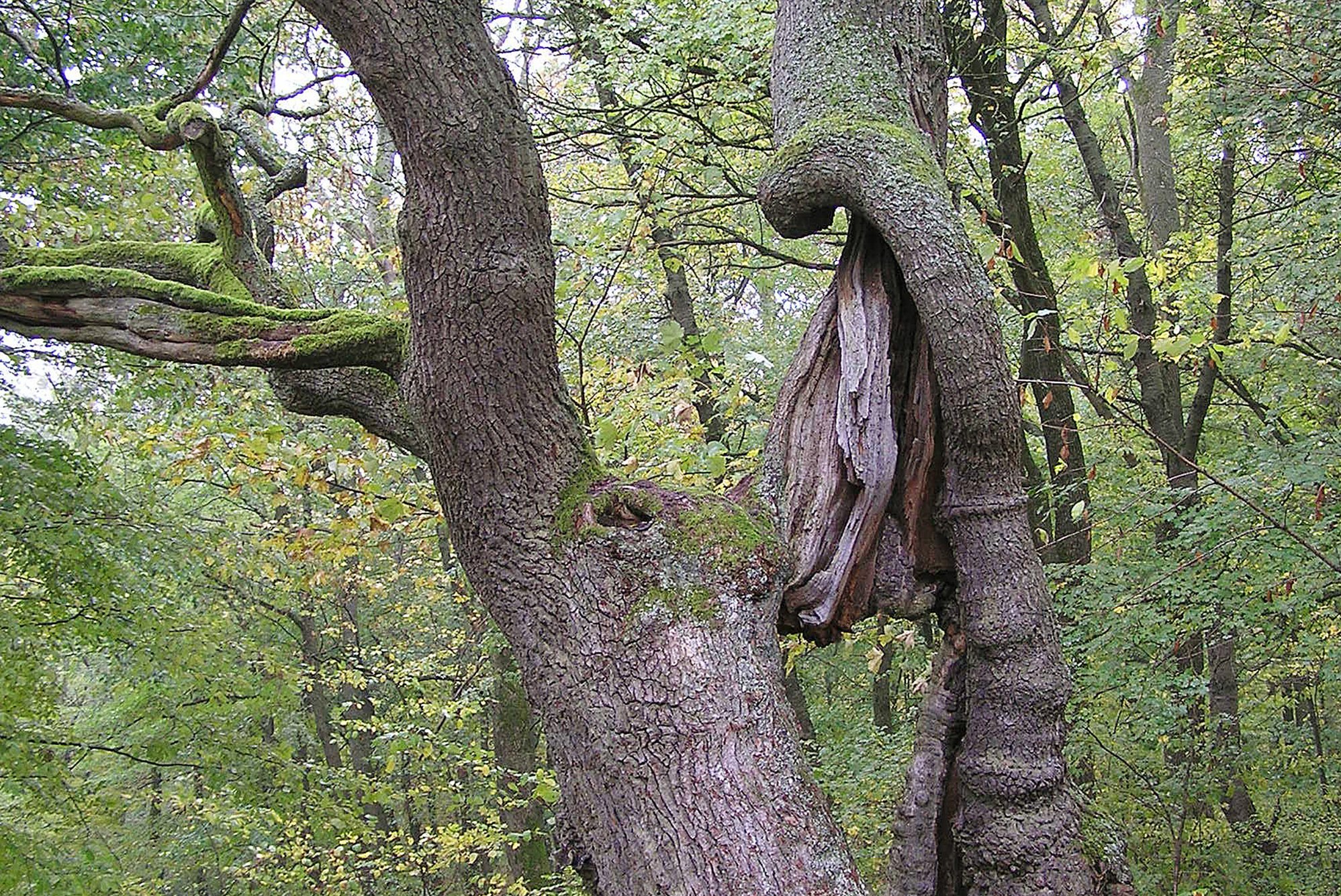
Fig. 1: This dendrotelm is one of many types of tree-related microhabitats. Photo: Rita Bütler (WSL)
Habitat trees and tree related microhabitats are becoming increasingly important for promoting biodiversity and understanding ecological relationships in our forests. Therefore, experts from Europe have developed a typology and a catalogue of tree related microhabitats (Kraus et al. 2016, Larrieu et al. 2018). These principles provide a standardised methodology for recording habitat trees and tree microhabitats in temperate forests.
Field guide to Tree-related microhabitats
The Field Guide to Tree-related Microhabitats (2025, 2nd ed.) systematically describes 52 tree microhabitats in the temperate climate zone. Based on this, a Field guide to Northern Tree-related microhabitats is available since 2024 (initially only in English).
Habitat trees – tree-related microhabitats
A habitat tree is defined as a tree bearing at least one tree-related microhabitat (fig. 2). A tree-related microhabitat (abbreviated as TreM) is a morphological feature present on a tree, which is used by sometimes highly specialised species during at least a part of their life cycle. These features may create shelters, breeding spots or crucial hibernating or feeding places for thousands of species.

Fig. 2. A habitat tree bearing tree-related microhabitats essential to specialised species for shelter, breeding spots, hibernating or feeding, or even for their entire life cycle (adapted from Emberger and Larrieu, eTreMs application).
Creation of tree-related microhabitats
Various biotic or abiotic events can create tree-related microhabitats: for example, a falling rock could injure the bark, lightning could strike a tree and crack open the wood, or a woodpecker could dig a breeding cavity in the trunk. For some TreMs like vertebrate nests or witches’ broom, the tree is merely a physical support. Only morphological features that are known to have a direct link with one or more associated species are classified as TreMs.

Fig. 3: Rockfall can injure the bark. Photo: Doris Hölling (WSL)
Each tree-related microhabitat provides very specific conditions depending on its characteristics: size, shape, position in the tree, degree of decomposition of the surrounding wood, state of the bearing tree (living or dead), exposure to sunlight, etc. Each associated species prefers a specific type of TreM. The more diversified the microhabitats in a stand, the greater the variety of species that can find the right conditions to thrive there. Since tree-related microhabitats have a limited life span, the more often the same type of microhabitat occurs in a stand, the easier it is for its associated organisms to colonize a new microhabitat when their previous support disappears.
Tree-related microhabitat forms
1. Cavities: holes or sheltered spots in the tree, dry or wet, with or without tree-hole mould, located on the trunk, in the crown or at the root collar.
- Woodpecker breeding cavity: cavity excavated by a woodpecker for nesting
- Rot-hole: cavity containing tree-hole mould (a mixture of decomposing wood, animal excretions and remains)
- Insect galleries: holes and galleries excavated by saproxylic insect larvae
- Concavity: hole or hollow in the wood, either wet or dry, or a sheltered spot with no mould and which was not excavated by insect activity
2. Injuries and exposed wood: sapwood or heartwood is exposed due to bark loss, splitting or breakage.
- Exposed sapwood: bark loss has exposed the sapwood only
- Exposed sapwood and heartwood: breakage or splitting has exposed both sapwood and heartwood
3. Crown deadwood: deadwood located in the crown of the tree.
4. Excrescences: Excrescences caused by a reaction of the tree to light or a bacterial, fungal or viral attack.
- Twig tangle: excrescence forming a dense packet of small twigs
- Burrs and cankers: ball-shaped excrescences of more or less dense woody material
5. Fungal fruiting bodies and slime moulds: the reproductive organs of saproxylic fungi or slime mould plasmodia, lasting at least several weeks.
- Perennial fungal fruiting bodies: the fruiting bodies of saproxylic fungi that develop over several years
- Ephemeral fungal fruiting bodies and slime moulds: the fruiting bodies of saproxylic fungi that develop over only one year, or slime mould plasmodia
6. Epiphytic and epixylic structures: structures or living organisms that use the tree mainly as a support.
- Epiphytic and parasitic cryptogams and phanerogams: vascular plants, mosses and lichens that use the tree as a physical support
- Nests: vertebrate or invertebrate nests (excluding woodpecker breeding cavities) placed in the tree or in a cavity
- Microsoil: a small amount of newly-created soil originating from the decomposition of organic matter from twigs, leaves, bark or mosses
7. Fresh exudates: fresh sap runs or resinosis.
Field Guide to Tree-related Microhabitats
Under the leadership of the European Forest Institute (EFI), experts from all over Western and Central Europe developed a TreM catalogue (Larrieu et al. 2018). It is hierarchically structured into: 7 forms divided into 17 groups and 52 different types. This hierarchical structure is useful for various purposes. For the quick selection of habitat trees when marking timber, the seven forms may be sufficient. For forest inventories or monitoring purposes, we recommend using either the 17 groups or the 52 types. The 52 defined microhabitat types are systematically described in the Field Guide to Tree-related Microhabitats (PDF; example in fig. 4).
In addition to German, English, French and Italian the Field Guide to Tree-related Microhabitats is also available in Spanish, Catalan, Portuguese, Dutch and Japanese (PDF).
Field Guide to Northern Tree-related Microhabitats
The 52 defined microhabitat types are systematically described in the Field Guide to Northern Tree-related Microhabitats (PDF). Five of them occur specifically in boreal and hemiboreal forests. The boreal forest (or taiga) is the world’s largest land biome, located in the high northern latitudes, between about 50°N and 70°N, where freezing temperatures occur for six to eight months of the year. It also contains recommended thresholds for field surveys or inventories and information on the frequency and rate of occurrence of each tree-related microhabitat:
Short films on tree-related microhabitats
The following short films with French and English subtitles result from a collaboration between three institutes: the Swiss Federal Institute for Forest, Snow and Landscape Research WSL, the Institut national de recherche pour l'agriculture, l'alimentation et l'environnement (INRAE) and the Centre national de la propriété forestière (CNPF) in France. Each video can be selected from the top right of the video [☰].
Literature
Further literature references used in the text can be found in the in the original publication (PDF) as well as in the WSL fact sheet Know, protect and promote habitat trees.
- Bütler, R.; Lachat, T.; Krumm, F.; Kraus, D.; Larrieu, L., 2021: Know, protect and promote habitat trees. WSL fact sheet, 64. 12 p. Download PDF
- Bütler R., Lachat T., Krumm F., Kraus D., Larrieu L. (2024) Field guide to tree-related microhabitats. Descriptions and size limits for their inventory in temperate and Mediterranean forests. (2nd ed.). Birmensdorf: Swiss Federal Institute for Forest, Snow and Landscape Research WSL. 64 p. Download PDF
- Bütler R., Larrieu L., Lunde L.F., Martin M., Nordén B., Reiso S., … Wetherbee R. (2024) Field guide to Northern Tree-related microhabitats. 68 p. Download PDF
You can order the printed publications free of charge from WSL:
WSL e-shop
Zürcherstrasse 111
CH-8903 Birmensdorf
e-shop@wsl.ch



![[Translate to English:] [Translate to English:]](/assets/_processed_/1/6/csm_markierung_hbg_f45990323c.jpeg)